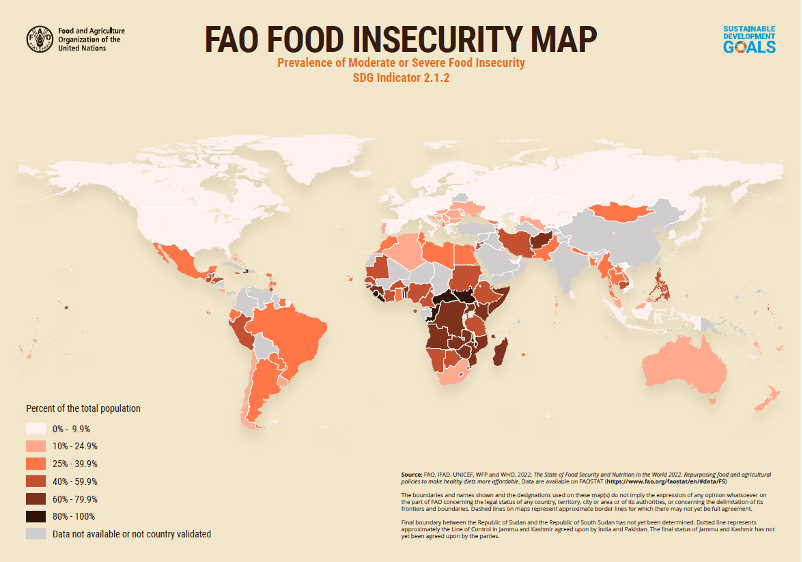Metropolis Report –
Seven years ago, world leaders made a bold commitment of eradicating hunger by 2030, which is more distant than ever now. Acute food insecurity now affects 345 million people in 82 nations, up from 135 million in 53 countries before the pandemic.
The number of individuals who go to bed hungry each night is as high as 828 million now. In addition, 49 million people in 49 nations are on the verge of starvation.
There are several convergent shocks that have led to the current levels of food insecurity. Since the Global Report on Food Crises’ initial release, conflict and insecurity have continued to be the leading causes of food insecurity worldwide.
Another significant factor raising the level of food insecurity is economic downturns. The COVID-19 pandemic’s repercussions on the world economy, notably on supply chains, inflation, and purchasing power, are still being felt today.
In addition, climate-related catastrophes like drought and flooding continue to make it difficult for many people to access and obtain food.
Russia’s invasion of Ukraine has just worsened the food insecurity scenario by affecting the global supply of grains and increasing the cost of energy and fertilizer. Due to Russian troops’ methodical occupation and shelling of Ukrainian arable land and agricultural machinery, this invasion has resulted in an increase in food costs.
Both Russia and Ukraine are significant food exporters; they provide 30 percent of the world’s wheat exports, 80 percent of the world’s sunflower oil, and 33 percent of the world’s cereal (maize and barley) exports.
Despite recent price reductions brought on by the EU Solidarity Lanes Initiative and the Black Sea Grain Initiative, prices are still about 7 percent higher than they were before the war and the market is still volatile.
The war is also having a negative effect on energy and fertilizer prices, whose rise continues to put upward pressure on food prices.
Afghanistan, Ethiopia, Nigeria, Somalia, South Sudan, and Yemen are among the six nations listed as being at risk of famine in the most recent Hunger Hotspot study, published in September. The Democratic Republic of the Congo, Haiti, Kenya, the Sahel region, Sudan, and Syria continue to be of extreme concern. The Central African Republic and Pakistan have also been added to the alert in the most recent version.

On the verge of this global disaster, China has been able to keep its domestic food supplies and prices stable even with the largest population in the world. In contrast to the global year-on-year increase of 25.2 percent, China’s local food price increased only by 0.4 percent in the first half of 2022. Their domestic grain production per capita was 483 kilograms in 2021, which was still higher as compared to the 400 kilograms per capita international criterion for food security.
Both the public and private sectors in China have made efforts to keep things stable. The Chinese government has implemented regulations in several areas, from market and end-use to production and transportation, to enhance food security.
The government has implemented a “farmland red line” program since 2006 to preserve at least 120 million hectares of arable land for crop farming. To improve the efficiency of transportation, key ministries also worked together to develop a “green channel” for fresh agricultural products. Other strategies have been devised to reduce food loss and waste throughout the entire food chain, which consumes 27 percent of the nation’s yearly production.
One of China’s key policy objectives is to support smallholder farmers, defined as those with less than 2-3 hectares of land under cultivation. Such 250 million smallholder farmers are the foundation of China’s food security, producing nearly 80 percent of the country’s food.
Leading Chinese businesses are aware that smallholders are crucial to their operations and the supply chain. For example, Syngenta Group China has been supporting smallholders through capacity-building initiatives to adopt sustainable farming methods to ensure the product is stable, robust, and of high quality.
To increase farmers’ skills in integrated pest management, conservation tillage, fertilizer application, and digital and financial literacy, Syngenta launched the Modern Agriculture Platform (MAP) in 2017. This has enabled MAP farmers to generate 240 US dollars more per hectare than non-MAP farmers while also producing high-quality goods.
Another new trend in China is the empowerment of agricultural products directly “from land to table” thanks to the country’s thriving e-commerce platforms. With the aid of technology, the leading e-commerce company, Alibaba, connected farmers of all sizes to its 903 million active users, aiding farmers and agricultural suppliers in their recovery from the epidemic.
Additionally, firms like Mengniu Dairy offer smallholders interest-free loans to hasten their recovery from the pandemic and maintain output. Mengniu, the largest dairy company in China, is using technological innovation to strengthen the entire industry and supply chain.
Blockchains and other new technologies, such as biotechnology, were used to boost production, reduce resource waste, and reduce carbon emissions while also achieving positive effects on the environment and the economy.




Very informative report. Thanks a lot